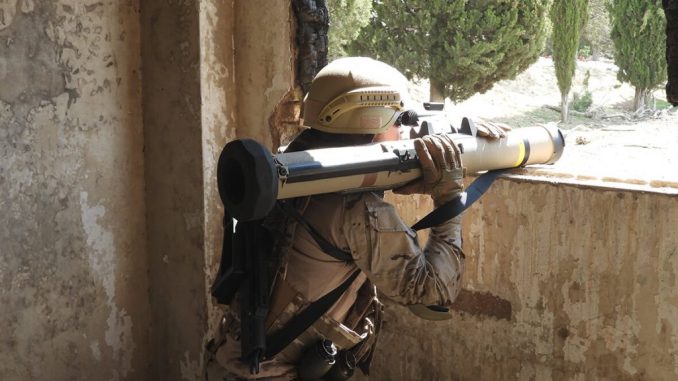
The C90 family of grenade launchers, designed, produced and constantly improved for decades by the Spanish company Instalaza, has been exported to almost forty countries, being used successfully on numerous occasions, the most recent in the Ukrainian war. For a few years now, a new system, known as CS90, has been added to the variants in the catalogue, both single-use and reusable. It has been expressly designed to be used from closed areas, thus responding to the demands posed by urban combat, which is increasingly important, as Ukraine has once again demonstrated. Furthermore, an evolution is in development that takes the range up to 600 meters, thus partly filling the gap between traditional grenade launchers and missiles such as the famous NLAW, at a cost that is a fraction of that of the latter.
The war in Ukraine, and before it the war in Nagorno-Karabakh, have shown that a substantial change is taking place in the way of fighting and, therefore, in the material needs of the armies. If until now and since the Second World War the strength of each army was measured by the number of platforms in service, generally monolithic and as advanced as budgets could allow, now the situation is changing. The proliferation of cheap sensors makes trusting everything to the big platforms of yesteryear too dangerous.
Vehicles such as battle tanks or armored transport or combat vehicles are increasingly easier to locate using drones or even static surveillance cameras acquired over the Internet, as was the case in northern Ukraine at the beginning of the war. . Furthermore, although in some cases they have shielding state of art and with active defense systems, they are very vulnerable given the growing number of anti-tank weapons in service, very effective and, in many cases, also very cheap in relation to the cost of the objectives to be destroyed. In fact, given the importance that electronics and optronics have acquired in the case of these vehicles, its total destruction is not even necessary, but it is enough to affect the optics or other sensitive elements to leave them out of combat, something that makes the work of anti-tank weapons or suicide drones even easier.
The consequence, in the future, will be a disaggregation in the platforms, since developments in artificial intelligence and the diffusion of COTS components will allow if not replace combat or armored tanks, yes distribute part of its elements among several smaller, cheaper and in some cases, dispensable vehicles. The idea, to understand us, is similar to what we see regarding combat aircraft, like the controversial European FCAS: a manned aircraft will control a variety of drones that will be exposed, obtain relevant data on targets and even launch attacks while the manned device remains safe both due to the protection offered by distance and its stealthiness.. In the case of land platforms, although battle tanks or armored vehicles of all types are not going to disappear, they will adapt to face new threats, as they have always done. Thus, will increasingly resort to more powerful cannons, NLOS weapons and indirect fire on the targets marked by drones closest to enemy positions. That is when they do not use those same drones to fire on the objectives.
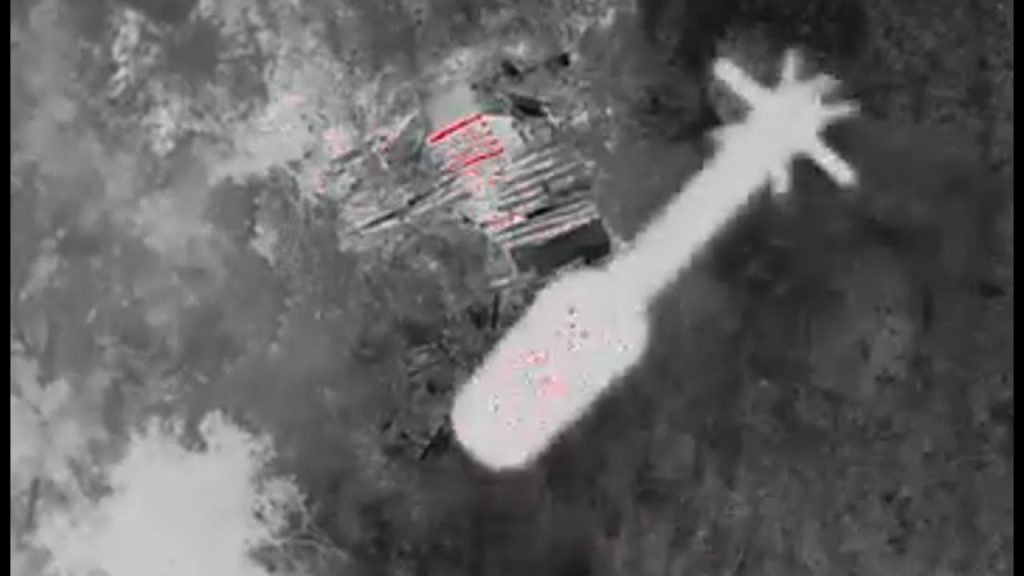
Paradoxically, none of this implies that the simplest anti-tank weapons - such as grenade launchers - will become obsolete in favor of options with greater range and complexity, such as new generation ATGMs. Quite the contrary, there are factors that force us to think that its role in future conflicts will grow.
- Firstly, as we have said, due to the proliferation of small land vehicles that complement the large platforms and for whose destruction it will be uneconomical to use missiles costing tens or even hundreds of thousands of euros.
- Secondly, because combat distances are shortening although this seems counterintuitive in a world in which the main powers are investing enormous sums in developing longer-range weapons. It is a consequence, among other things, of the growing importance of urban combat and will be reinforced by the disaggregation of platforms and the multiplication of unmanned ones, since they will allow us to get closer to the enemy.
- Thirdly, because the development of a wide variety of warheads - bunker-proof, fragmentation, overpressure... - gives them a versatility that was unthinkable some time ago.
- Fourthly, because solutions are emerging that substantially increase the range of grenade launchers, as in the case of the CS90-ER from Instalaza, which we will talk about later. Now, thanks to the inclusion of cruise engines, ranges that until now were around 300 meters are practically doubled, covering a space that was previously reserved for much more expensive missiles.
- Fifthly, because the possibility of using some systems from closed areas makes them much more suitable for urban combat, since they can be fired from buildings of all types.
In summary, far from being condemned to disappearance, grenade launchers are going to be more common if possible in the future, given that they are easy to transport systems, with little or no maintenance, with a great cost/effectiveness ratio, capable of attacking a great variety of objectives and being lethal even in inexperienced hands thanks to its reduced learning curve. It is for all these reasons that we found it interesting to dedicate an article to the CS90 and CS90-ER from Instalaza, since they are unique products due to different factors that we will explain in the next sections, and also Spanish.
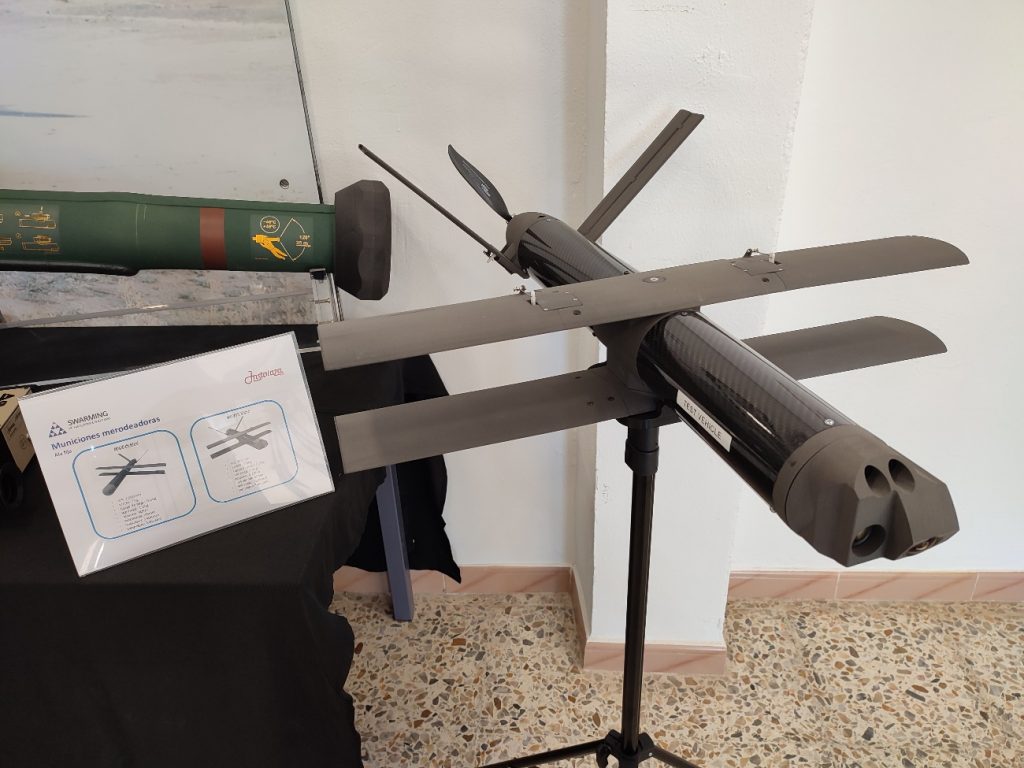
Visit to the Instalaza facilities
In preparation for this article, we had the opportunity to visit the facilities of the Zaragoza company Instalaza S.A. at the CENAD of San Gregorio. There, the company has, among others, a shooting range and a laboratory in which they test both the range and precision of their weapons as well as their lethality and penetration capacity in various conditions.
Once there, we were able to see in situ the possibilities of some of their latest developments, talk about the projects they are embarking on - to which we may dedicate a new article in the future - and especially see the CS90 in operation. This has been the name chosen to name the latest evolution of the well-known C90, optimized to be used from closed areas, an essential feature in urban combat, as we are seeing in Ukraine, but which constitutes a real challenge when it comes to being implemented. . All, in addition, maintaining the traditional advantages of the C90 compared to comparable systems, such as its size, its reduced weight, its precision and its lethality, in addition to its compatibility with the rest of the company's products, in the case of night vision scopes. , as well as with the different training systems, including the SAARA simulator.
Although it is not the subject of this article, we cannot resist commenting that in the facilities we were able to see various components and systems produced by the company, some of them still in development, such as the guided projectile for the Alcotán on which they work together with Escribano Mechanical & Engineering, an interesting loitering ammunition or those related to the integration of its ammunition in small UGVs.
Returning to the topic at hand, after an interesting explanatory talk by the CEO of Instalaza, we headed to the shooting range, where the demonstrations began with a test of the Alcotan 100 warhead, which proved to be capable of penetrating 700 mm of steel, plus an ERA shielding module. We were also able to see the effect of overpressure munitions when they detonate in a naval container, simulating the effects they would cause if they did so inside a bunker or a cave - these munitions are used to replace the controversial thermobaric weapons, such as those launched by the TOS-1 that Russia is using in Ukraine.
Subsequently, we witnessed several launches of the C90-CR - a variant in use in our FAS - both against a concrete wall and against a 480mm steel plate, among others. In all cases the grenades more than demonstrated their capacity. It must be said that it was a very windy day, with gusts of 60 km/h, something common in San Gregorio, where the storm arrives in full force. However, all shots were accurate, something worth noting given that these are not guided weapons.
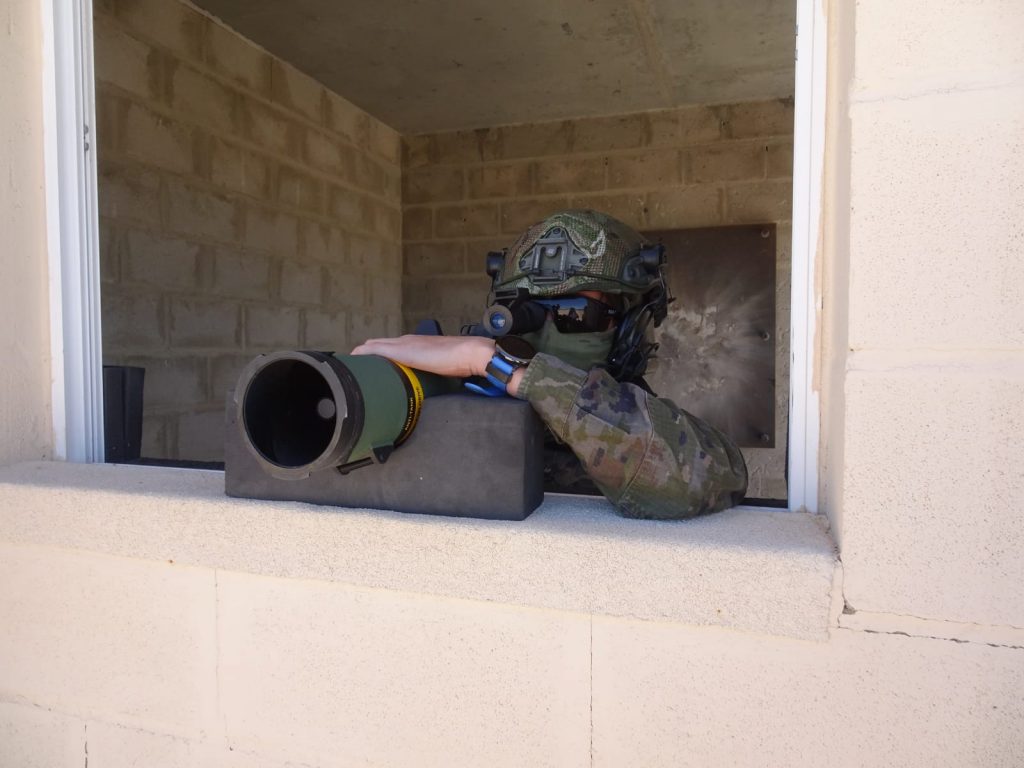
Once the first tests at the shooting range were completed, we were able to test the SAARA simulator, which, using a projector or using a fixed screen, allows anyone to become familiar with the operation of the company's family of grenade launchers without danger or hardly any cost, more beyond acquiring the system. The person writing these lines had the opportunity, as a soldier, to use it on several occasions, so he had an advantage. However, everyone present, after a few instructions from the company's staff, was able to hit the target after one or two attempts. In addition, the simulator allowed them to mechanize the assembly, safety removal and firing movements. After all, that is one of the great advantages of simulators, as we explained in an ad hoc article: they allow you to do these things in complete safety, repeating them as many times as necessary and at a ridiculous cost if we compare it with the thousands of euros that each shot can cost.
Once we had learned the basics of use, we headed outside again, where we were able to shoot both with the TR90-BT subcaliber system, which uses a 9 mm tracer bullet instead of a rocket-propelled grenade - which greatly reduces the cost of use -, as with the TR-ALC, in this case for the Alcotán 100. Although in some cases we managed to hit the target from the first shot - we have already commented that we started with an advantage -, in all cases - there were companions Defensa, Infodefensa and FAM - after a couple of attempts the shooters managed to reach the target.
The most interesting thing, however, came next, when two operatives from the Special Operations Command made several launches, both in the open and from a closed area. It must be said that the booth from which the shots were fired was really small, barely 3x3 meters and that it only had a window of around 1m2 from which the operators fired, as well as a normal-sized door. on the left side of it. The latter is important, since it is quite common for companies to falsify test results by placing the door at the back, so that the cone of pressure, smoke and fire that expels the ammunition instead of remaining inside the enclosure can be Part out the door. In this case, we can assure that this was not the case, but that most of it remained inside the premises without the operators suffering any consequences, which deserves an explanation.
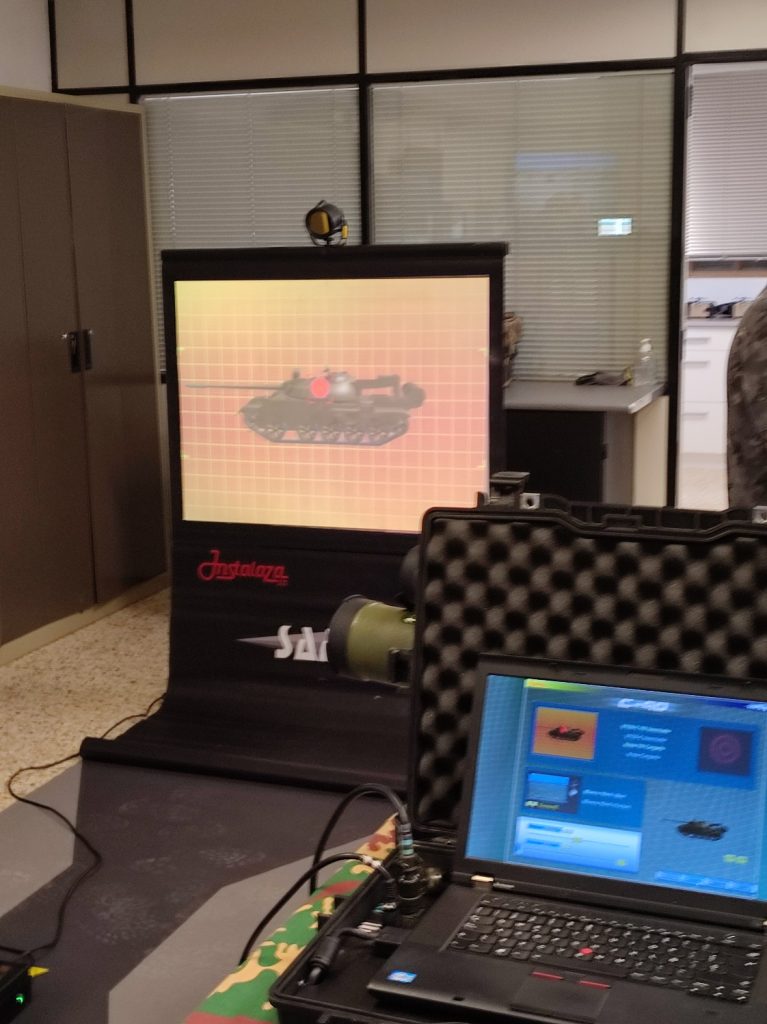
CS90: Features and variants
The CS90, as we have anticipated in previous sections, is a variant of the C90 designed expressly to be used from closed spaces. It is produced in three versions: CS90-AT (anti-tank), CS90-DP (dual purpose anti-armor + fragmentation) and CS90-BK (anti-bunker). In all cases they share the same “packaging”, which is practically identical to that of the C90-CR, not in vain the company has placed emphasis on the maximum commonality of components. In this way the CS90 uses the same firing system, a canisters with the same handling and very similar in appearance, although with a different design and construction technology, based in this case on carbon fiber and the same 2x viewfinder, fundamentally changing the propulsion system used.
With a weight that ranges between 6,7 and 7,2 kg depending on the warhead, it has an effective range against point targets of 350 meters (effective range is understood to be that distance in which, against a point target the system has a probability of destroying the target of 70%). In the case of area targets, for which the CS90-DP would be used, it reaches up to 700 meters, maintaining acceptable precision.
Regarding the penetration capacity, the CS90 can penetrate, in the case of anti-tank ammunition (CS90-AT), half a meter of steel (500 mm) or more than one meter of concrete (>1.000 mm). Needless to say, very few tanks can withstand, depending on the point of impact, the attack of such a weapon. The same in the case of buildings, since even bunkers do not usually have walls thicker than 250-350 mm. The dual-purpose anti-armor + fragmentation variant (CS90-DP) is capable of penetrating up to 22 cm (220 mm) of steel or more than half a meter of reinforced concrete (<500 mm). It is surely the most versatile of the options offered by the CS90 family, since there are not many armored vehicles that can withstand an impact of this type and its fragmentation head is divided into more than 1.000 fragments. Finally, the bunker-proof version (CS90-BK) despite having a lower penetration capacity; 120 mm of steel or 300 mm of reinforced concrete, it has the advantage of having a second fragmentation head that, once crossed the bunker wall, is capable of neutralizing anything inside within a radius of several meters thanks to to the dispersal of more than 2.500 fragments.
To be able to be fired from inside, the CS90 uses a countermass gun. This system allows the projectile to benefit from a greater muzzle velocity, using only a quarter of the propellant charge required by, for example, the C90-CR. Since the load is smaller, so is the amount of gases expelled. This implies a smaller projection cone and the signatures, both thermal and acoustic, are much smaller than those of other systems. It is not a trivial question, for two reasons:
- First of all, because when we talk about modern combat, we talk about battlefields full of sensors as we explained at the beginning of the article. In these conditions, discretion becomes more important every day. In this sense, the CS90 is theoretically more difficult to detect when fired than any other comparable system, be it the Swedish Carl Gustav, the German RGW90, etc.
- Secondly, because of the effect that each shot has on the operator who carries it out. Naturally it can be argued that in the event of war job security should take a backseat to the ability to inflict harm on the enemy, however it is not that simple. Depending on the system we are talking about, an infant, even using double protection, could barely fire between one and six shots a day, with the risk of losing hearing, suffering the consequences of high temperatures, etc. In the case of the CS90, this figure grows to ten shots per day carried out in complete safety and that only with simple protection. It may seem trivial, but no self-respecting army wants to lose a well-trained infantryman due to a hearing or any other type of problem, since each uniformed soldier is a much more valuable resource than the weapons system he uses.
Another aspect that should be highlighted about the CS90, like the C90-CR, is that they are single-use systems, with all the advantages that this entails and which are worth expanding on, precisely because it is a topic that is rarely discussed. explains in conditions. For some reason, we instinctively tend to think that a grenade launcher like the well-known RPG-7, in which the grenades are very light and can be carried separately, in sometimes the most bizarre ways, is much more useful than another in which the grenade is integrated into a disposable launcher. Things, however, are not so simple:
- First, a reusable system requires two operators, one to transport the launcher and another to carry the ammunition.
- Reusable systems require periodic maintenance that in some cases is not only expensive, but also complex, which is why it cannot be carried out at the first steps, but must be carried out by factory personnel. This practically rules it out for some types of units such as Special Operations that have no possibility of making field repairs of any kind.
- Reusable systems lose precision with use, due to the small deformations accumulated in the tube after each launch.
- The time to take each shot is longer, since since it cannot be carried more than a few meters, since they are not designed for this, the grenade must be inserted before use and the server has to take shelter instead of aiming and shooting directly a single operator.
- If the launcher is damaged by a blow or any other reason, you can no longer fire it no matter how many ammunition you have, something that does not happen with single-use ones, since each ammunition is a weapon.
- The disposable is very resistant, designed to withstand drops of 1,5 meters, to be transported in spartan conditions bouncing for thousands of kilometers aboard a trailer and is waterproof, resisting the elements (rain, dust, sunlight...).
- In the particular case of closed-chamber ammunition, they are more damaging to the tube, making a disposable system preferable.
- The difference between carrying single-use variants and disposable ones is not as important as you might think. In fact, at best it is 3 against 4 since each grenade for a disposable system goes inside an individual tube that occupies a considerable volume.
That is to say, the advantages of disposable systems far exceed those of reusable ones, which are only requested by armies that: 1) have maintained immutable doctrines for decades or; 2) they carry out intensive anti-tank training, so they opt for a solution with which they can save money given the amount of ammunition they use per year.
That said, the CS90 promises to maintain all the features that have made the C90-CR what it is, but adapting much better to future scenarios, with special emphasis on urban combat.
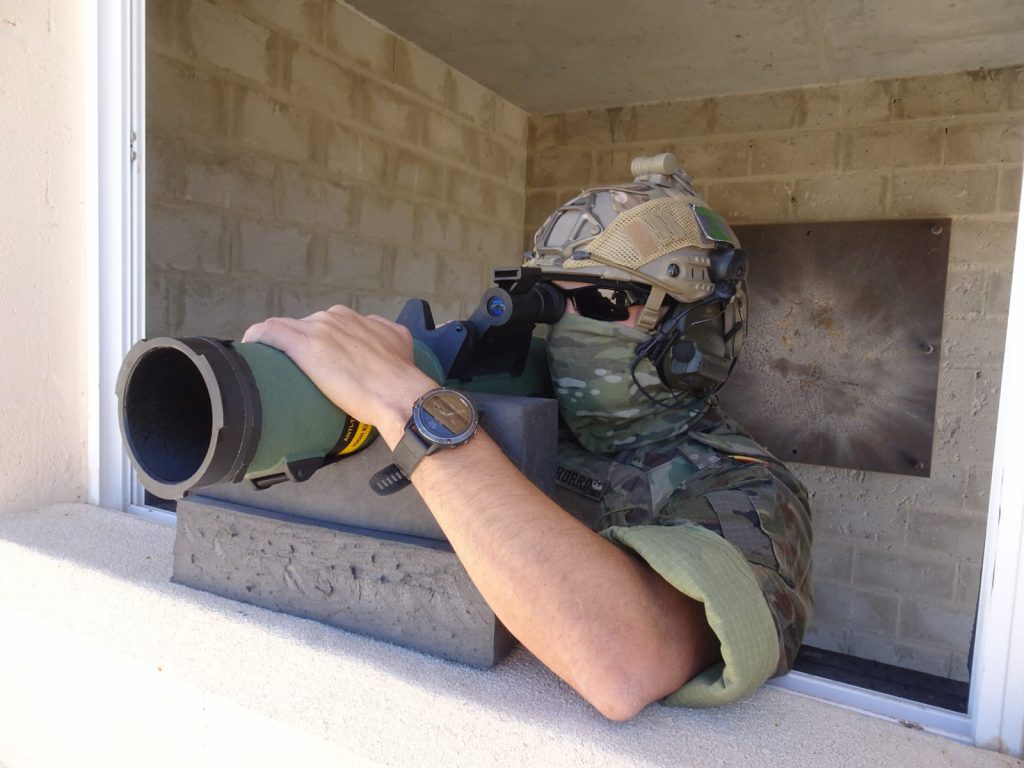
CS90-ER (Extended Range)
In the first section of the article we explained that in some ways a paradox was occurring: while weapons with greater ranges continue to be developed, combat distances in some scenarios are being reduced. Although there are studies that show that most combats occur at distances between 600 and 1.500 meters, this is something that has been changing in recent years, as urban combat has gained relative importance compared to confrontations in desert terrain or even those envisaged in the plains of central Europe during the Cold War. The war in Ukraine is a good example of this, with constant clashes at much smaller distances, whether in towns and cities, or in forested areas or with complicated terrain. It is true that in part it is due to the Ukrainian inability to fight at the operational level, which reduces your options almost exclusively to the tactical, but even so there are structural factors that will make the trend continue and that we have already listed.
If we look at what we have seen in Ukraine, but also in other places such as Syria, we could establish as more reasonable an ordinary combat distance of between 300 and 1.000 meters in relation to the use of anti-tank or bunker-busting weapons, the latter function for which Many times ATGMs are used, which are too expensive considering the destroyed objectives.
Of course, distance - understood as an isolated element - is not the only factor that we must take into account when establishing the type of systems necessary for certain situations. To begin with, because each unit is part of a fire bubble in which the range of its weapons must complement that of those used by the units above and below it, so it does not make sense that at the platoon level They use exactly the same weapons as at company level, or at least not in professional and well-designed armies, since the case of guerrillas and others is different. Also because for the same scope, certain capabilities become determinants (fire and forget, remote shooting capacity, disposable, the possibility of being used from closed areas...). Of course, price is another important factor, the same as weight or ergonomics. Therefore, for a given need, it is about finding the best balance between various factors, such as range, lethality, portability, ergonomics, maintenance requirements and price.
In Ukraine we have witnessed the success - not without problems - of the NLAW and the Javelin, sent to the detriment of older and bulkier options such as the TOW 2 and even other modern ones with greater range such as the Spike LR and ER. More unnoticed has been the role played by other weapons, including the C90-CR that have been sent by countries like Estonia and Spain and which have also been used widely, as have the M72 LAW, the MATADOR or the AT4 among others. All of these systems, in a scenario in which distance is not crucial, are capable of offering an unparalleled cost/effectiveness ratio given their cost of a few thousand euros, compared to tens of thousands or more for anti-tank missiles. .
It is this difference in price and performance, with an obvious jump between ATGMs that measure their range in several kilometers and anti-tank guns and grenade launchers, much cheaper but generally with ranges that do not exceed 300-350 meters, which now touches fill out. Precisely filling this gap is one of the reasons behind the success of the NLAW and why the Alcotán is so important. However, a wider range of options is needed and, if possible, cheaper and lighter systems.
This is where the CS90-ER (Extended Range) comes in, which Instalaza is finishing developing and hopes to have ready at the beginning of 2023. This evolution of the CS90 will use part of the Alcotán propellant technology to shoot down targets up to 600 meters without need for direction of fire, that is, using only the two-fold folding optics standard on the C90. The weight difference compared to the ordinary CS90 is minimal despite everything, giving scale data of less than 7 kg without the penetration capacity being altered.
The company's solution involves incorporating a cruise engine that not only increases the range - against specific targets, not area targets - by 250 meters, but also allows the deviations caused by side wind to be corrected. You have to think that when a projectile accelerates during its journey, it tends to deviate in the opposite direction to that of the wind, while when it decelerates along its path, it deviates in favor of it. Thanks to the cruise motor, the speed is linear, which solves the problem of precision, since the technical challenge is not so much to increase the range, but rather to maintain the chances of hitting the target without the need to incorporate a guidance system or an aiming system. complex as Alcotán itself has, which uses the VOSEL reusable firing direction. In this case, an integrated computer calculates the position and trajectory of the target, measures the temperature of the propellant, calculates the trajectory of the projectile and shows the operator the future point that will allow him to maximize the probability of impact. For its part, in the case of the CS90 everything is much simpler, aiming in a traditional way using crosshairs and distance and movement marks, although the system is actually prepared to use a future version of VOSEL if the client requests it.
In summary, the CS90-ER could be considered a kind of hybrid between the C90-CR and the Alcotán 100, with the added advantage compared to the C90-CR of being able to be used from closed spaces, which makes it today a product unique, both in price and performance.
Conclusions
War is a phenomenon in constant mutation. What has been seen in the latest conflicts and the indicators on future trends point towards the growing importance of grenade launchers, ideally optimized for urban combat, capable of reaching distances greater than current ones and for single use.
With the arrival of the CS90 and CS90-ER, Instalaza has managed to complete an already successful family, with a product more suitable for the scenarios we are talking about. Furthermore, thanks to the Extended Range version, it partly covers the gap between traditional grenade launchers and systems that are much more expensive to purchase such as ATGMs, without sacrificing precision or versatility and without increasing the weight significantly, or increasing the price. that remains contained. All these arguments place it ahead of its direct competition, such as the Swedish M4 Carl Gustav or the German RGW90, which is why the Italian "San Marco" brigade has decided to opt for this system.
What is more important, qualities aside, it is a system entirely developed and produced in Spain, by a Spanish company that invests 8% of its sales in R&D&I, which designs and manufactures from the tubes of the grenade launchers and warheads to electronics or optics, which exports more than 80 percent of what it produces and maintains almost 200 highly qualified jobs. A company that, thanks to the above, does not need any more license to export than the one granted by the Spanish authorities, since it does not depend on third-party components and, therefore, does not depend on their approval either. The latter, as we have been defending for years, is true industrial sovereignty, something that we must protect at all costs.

Be the first to comment